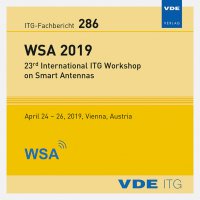Conducted Beamforming Testing in the Millimeter Wave Spectrum
Konferenz: WSA 2019 - 23rd International ITG Workshop on Smart Antennas
24.04.2019 - 26.04.2019 in Vienna, Austria
Tagungsband: WSA 2019
Seiten: 6Sprache: EnglischTyp: PDF
Persönliche VDE-Mitglieder erhalten auf diesen Artikel 10% Rabatt
Autoren:
Janßen, Andre; Widell, Svante; Wehinger, Joachim (Intel Deutschland GmbH, Neubiberg, Germany)
Monghal, Guillaume D. (Intel Corp., San Diego, USA)
Inhalt:
The advent of millimeter wave (mmW) communications in standards like 3GPP-NR (New Radio) and IEEE802.11ad mandates the use of analog beam-forming mechanisms to overcome the path-loss challenge introduced at carrier-frequencies higher than 8 GHz. Since the expression of the beam-pattern becomes an essential part of the overall wireless channel it must be included during end-to-end system performance testing. However, the antenna arrays required to perform active beamforming at mmW can require many elements and a tight integration with RF components. This renders the testing of performance at mmW with active beamforming using a traditional RF fader essentially impossible. As a result, the only vehicle to test an end-to-end mmW system with active beamforming is an over-the-air (OTA) chamber including both transmitter and receiver. This, however, comes with two issues. First of all, only very simple wireless channels can be tested in a single OTA chamber, while literature shows that mmW channel can have non-trivial fading characteristics w.r.t. delay-spread and directivity. Secondly, due to the necessity to test mmW systems in far-field distance OTA chamber may be very large and costly to scale. In the present paper we describe a novel approach that we call “New Fader”. The presented methodology allows to shift large parts of OTA-based-testing to a conducted testing where algorithmic and performance behavior can be analyzed more efficiently. The resulting setup allows for end-to-end mmW performance testing of 5G-NR or WiGig in a conducted fashion as it was done in cellular phone systems like GSM, UMTS, and LTE. The heart of the proposed arrangement is the “New Fader”. It absorbs the functionality of the 3D spatial propagation channel, the beamforming on gNodeB (gNB)- as well as User-Equipment (UE)-side, and the movement models.


